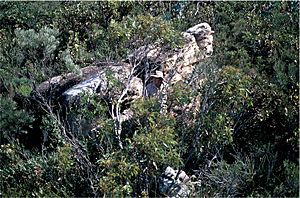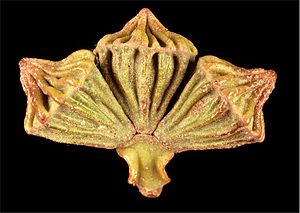Crowned mallee facts for kids
Quick facts for kids Crowned mallee |
|
|---|---|
 |
|
| Eucalyptus coronata in the Fitzgerald River National Park | |
| Conservation status | |
| Scientific classification | |
| Genus: |
Eucalyptus
|
| Species: |
coronata
|
| Synonyms | |
|
Eucalyptus mitrata C.A.Gardner |
|
The Crowned Mallee (Eucalyptus coronata) is a special type of eucalypt tree. It only grows in a small area on the south coast of Western Australia. This plant has smooth bark and interesting leaves. Its flower buds have clear ribs, and its fruit looks like a crown. The flowers can be white, cream, or yellow.
Contents
What Does the Crowned Mallee Look Like?
The Crowned Mallee is a multi-stemmed plant. This means it has many stems growing from its base. It usually grows to be about 0.6 to 5 meters (2 to 16 feet) tall. It also has a special woody swelling underground called a lignotuber. This helps the plant regrow after a fire.
Bark and Leaves
The bark of the Crowned Mallee is smooth. It can be a pale gray or light brown color. Its adult leaves are bluish-green. They are shaped like a spear or slightly curved. These leaves are about 70 to 130 mm (2.8 to 5.1 inches) long. They are also 13 to 25 mm (0.5 to 1 inch) wide. Each leaf sits on a stalk called a petiole, which is 12 to 28 mm (0.5 to 1.1 inches) long.
Flower Buds and Flowers
The flower buds of the Crowned Mallee grow in groups of three. They appear where the leaves meet the stem, which is called the leaf axil. These buds sit on a flat stalk called a peduncle. This stalk is about 10 to 17 mm (0.4 to 0.7 inches) long. The buds themselves are diamond-shaped. They are quite large, about 27 to 30 mm (1.1 to 1.2 inches) long. They also have many clear ribs along their sides. The top part of the bud, called the operculum, looks like a beak.
The Crowned Mallee flowers between April and May, or from July to November. Its flowers are usually white or cream-colored. Sometimes, they can be yellow.
Fruit of the Crowned Mallee
After flowering, the plant produces woody fruit. This fruit is shaped like a broad cone. It is about 17 to 25 mm (0.7 to 1 inch) long. It is also very wide, about 32 to 53 mm (1.3 to 2.1 inches). The fruit has very noticeable ridges. These ridges, along with the parts that stick out, make the fruit look like a small crown. This is how the plant got its name!
How the Crowned Mallee Got Its Name
The scientific name for the Crowned Mallee is Eucalyptus coronata. It was first officially described in 1933. A botanist named Charles Gardner gave it this name. He published his description in a science journal.
Meaning of "Coronata"
The word "coronata" comes from the Latin word coronatus. This word means "crowned." Gardner chose this name because of the plant's ribbed operculum (the cap on the flower bud) and its crown-like fruit. Another name, Eucalyptus mitrata, was also used for a while. However, it is now considered the same species as E. coronata.
Where Does the Crowned Mallee Grow?
The Crowned Mallee grows in a specific area in Western Australia. It is found in the Fitzgerald River National Park. This park is located along the coast.
Habitat and Soil
You can find this plant growing on coastal hills. It prefers sandy soils that are not very deep. It also grows on rocky hillsides made of quartzite. This plant likes to live in areas with heathland plants. These are low-growing shrubs that are common in this region.
Why Is the Crowned Mallee Special? (Conservation Status)
The Crowned Mallee is considered a "vulnerable" species. This means it is at risk of disappearing. The Australian Government lists it as vulnerable under a special law. It is also listed as "Threatened Flora" by the local environment department.
Protecting the Species
There are only three known groups of Crowned Mallee plants left. All of them are inside the Fitzgerald River National Park. Scientists estimate there are about 140 plants in total. They are spread out over an area of about 47 square kilometers (18 square miles).
The number of plants has changed over time. This is because of bushfires. Fires happened in 1989, 1990, and 2006. These fires can affect how many plants survive. The main dangers to the Crowned Mallee are road work and wildfires. Protecting these plants is very important.
Using the Crowned Mallee in Gardens
The Crowned Mallee can be grown in home gardens. It is a good choice for small landscaping projects. People use it as an ornamental plant because it looks nice. It can also be used for hedging, which means planting many together to form a border. Bees also like its flowers, so it can be good for honey production.
Growing Conditions
This eucalypt is quite tough. It can handle both frost and drought. It can grow in many different types of soil. It even does well in soils that don't have many nutrients or are a bit acidic.



